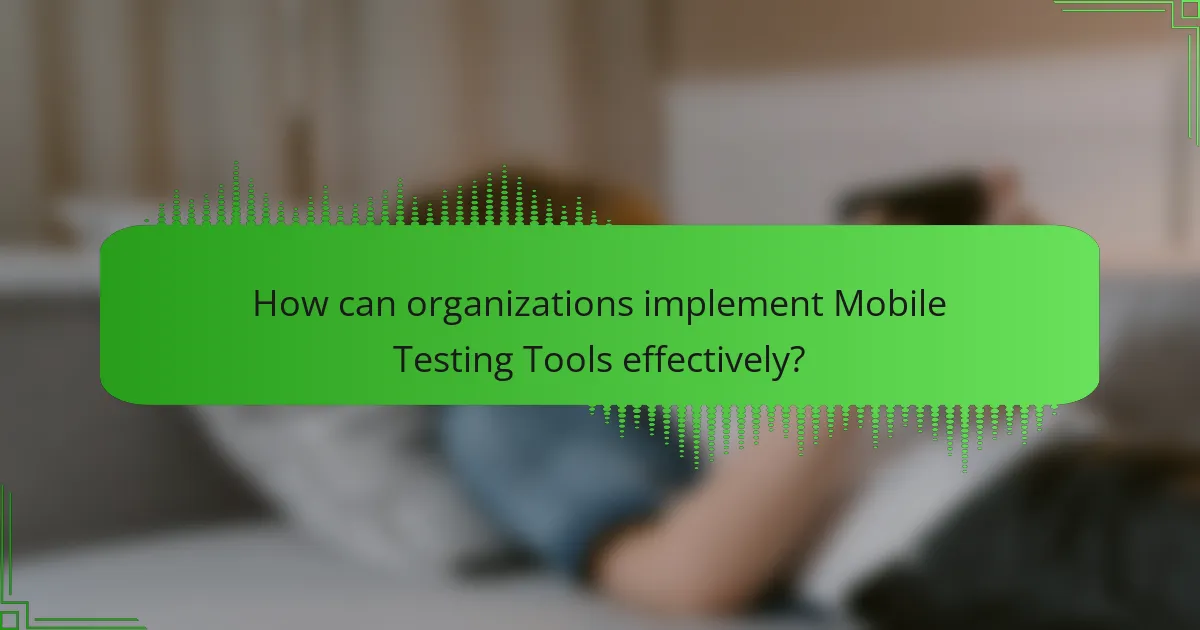Mobile testing tools are software applications that facilitate the testing of mobile applications to ensure their proper functionality across different devices and operating systems. This article outlines the various types of mobile testing tools, including automated testing, performance testing, and user experience testing, highlighting popular options such as Appium, Selenium, and TestComplete. It also discusses best practices for implementing these tools effectively within organizations, emphasizing the importance of identifying specific testing needs, training team members, and integrating tools into existing workflows. Additionally, the article explores future trends in mobile testing, including increased automation, AI integration, enhanced performance testing, and the growing significance of security testing and cloud-based solutions.

What are Mobile Testing Tools?
Mobile testing tools are software applications designed to facilitate the testing of mobile applications. They help ensure that apps function correctly across various devices and operating systems. These tools can perform a range of functions, including automated testing, performance testing, and user experience testing. They enable testers to identify bugs and issues before an app’s release. Popular mobile testing tools include Appium, Selenium, and TestComplete. These tools support both Android and iOS platforms. They often provide features like real device testing, emulators, and simulators. Mobile testing tools are essential for maintaining app quality and user satisfaction.
How do Mobile Testing Tools function?
Mobile testing tools function by automating the testing process for mobile applications. They simulate user interactions on mobile devices to identify bugs and performance issues. These tools can run tests on various operating systems, such as Android and iOS. They provide features like recording user actions, generating test scripts, and reporting results. Many tools support both manual and automated testing approaches. Some tools allow for cloud-based testing, enabling access to a wide range of devices. They often integrate with Continuous Integration/Continuous Deployment (CI/CD) pipelines. This integration helps streamline the testing process in software development.
What are the key components of Mobile Testing Tools?
The key components of mobile testing tools include test automation, device compatibility, and performance testing. Test automation enables the execution of test cases without manual intervention. This increases efficiency and coverage. Device compatibility ensures that applications function correctly across various devices and operating systems. Performance testing assesses the application’s responsiveness and stability under different conditions. Additionally, user interface testing verifies that the app’s design meets user expectations. These components collectively enhance the quality and reliability of mobile applications.
How do these components interact during testing?
Components interact during testing through a systematic process that evaluates functionality, performance, and usability. Testing tools, devices, and environments work together to simulate real-world conditions. The testing tools execute test cases designed to assess the mobile application. Devices provide the hardware and operating systems that the application runs on. Environments, including network conditions, contribute to testing various scenarios. Data collected during testing informs developers about issues and performance metrics. This interaction enables continuous feedback and improvement of the application. Each component’s role is critical in ensuring a comprehensive evaluation of the mobile application.
What types of Mobile Testing Tools are available?
There are several types of mobile testing tools available. These tools can be categorized into various types based on their functionality. Functional testing tools ensure that the mobile application performs its intended functions. Performance testing tools assess the speed and responsiveness of the application under different conditions. Usability testing tools evaluate the user experience and interface of the app. Security testing tools identify vulnerabilities within the mobile application. Automation testing tools facilitate the execution of tests without manual intervention. Compatibility testing tools check the application’s performance across different devices and operating systems. Each type of tool serves a specific purpose in the mobile testing process.
What are the differences between manual and automated testing tools?
Manual testing tools require human intervention to execute test cases. Automated testing tools use scripts to perform tests without human involvement. Manual testing is often used for exploratory, usability, and ad-hoc testing. Automated testing is ideal for regression, performance, and load testing. Manual testing can be time-consuming and prone to human error. Automated testing offers speed and repeatability, reducing the risk of errors. Manual testing allows for more intuitive feedback and insights. Automated testing requires initial setup and maintenance but saves time in the long run.
Which tools are best for performance testing?
Apache JMeter, LoadRunner, and Gatling are among the best tools for performance testing. Apache JMeter is open-source and widely used for load testing web applications. LoadRunner offers comprehensive features for performance testing across various environments. Gatling is known for its high performance and ease of use in simulating large user loads. Each tool provides unique capabilities tailored to different testing needs. JMeter supports various protocols, while LoadRunner integrates well with enterprise applications. Gatling’s scripting is efficient for developers familiar with Scala. These tools are validated by their extensive use in the industry and positive user feedback.
What tools are commonly used for UI/UX testing?
Commonly used tools for UI/UX testing include UserTesting, Lookback, and Optimal Workshop. UserTesting allows for user feedback through recorded sessions. Lookback provides live user testing and interviews for real-time insights. Optimal Workshop offers usability testing tools for card sorting and tree testing. Other notable tools are Maze, which enables rapid prototyping and user testing, and Hotjar, which provides heatmaps and session recordings. These tools help gather user data to improve design and functionality.
What advantages do Mobile Testing Tools provide?
Mobile testing tools provide several key advantages. They enhance the efficiency of the testing process. Automated testing saves time compared to manual testing. These tools support multiple devices and operating systems, ensuring broader coverage. They also facilitate early detection of bugs, which reduces overall development costs. Additionally, mobile testing tools improve test accuracy through consistent execution. They enable real-time performance monitoring, allowing for immediate feedback. Lastly, many tools offer integration with CI/CD pipelines, streamlining the development workflow.
How do these tools improve app quality?
Mobile testing tools improve app quality by automating the testing process. They enable consistent and repeatable tests, reducing human error. These tools facilitate early detection of bugs, allowing developers to address issues promptly. They also support a variety of devices and operating systems, ensuring compatibility. Additionally, performance testing tools assess app responsiveness under load, enhancing user experience. According to a survey by TechBeacon, automated testing can increase test coverage by up to 70%. This comprehensive testing leads to more reliable and user-friendly applications.
What cost savings can be achieved through effective mobile testing?
Effective mobile testing can achieve significant cost savings. By identifying bugs early, companies can reduce the cost of fixes. Fixing issues during development is cheaper than post-launch corrections. Efficient testing minimizes the risk of app failures, which can lead to lost revenue. Automated testing tools can decrease manual testing time and labor costs. A report by Capgemini found that organizations using automated testing saw a 30% reduction in testing costs. Additionally, effective mobile testing improves user satisfaction, leading to higher retention rates and reduced customer acquisition costs. Overall, effective mobile testing streamlines the development process and enhances profitability.
How do Mobile Testing Tools enhance user experience?
Mobile testing tools enhance user experience by ensuring applications function correctly across various devices. These tools automate the testing process, reducing human error and increasing efficiency. They enable developers to identify bugs and performance issues before the app reaches users. By simulating real-world conditions, mobile testing tools provide insights into how users will interact with the app. This leads to improved usability and satisfaction. According to a study by the International Journal of Computer Applications, automated testing can reduce testing time by up to 80%. Faster release cycles allow for timely updates and feature enhancements, further boosting user experience.

How can organizations implement Mobile Testing Tools effectively?
Organizations can implement Mobile Testing Tools effectively by following a structured approach. First, they should identify the specific testing needs for their mobile applications. This includes understanding the target devices and operating systems. Next, organizations must select appropriate mobile testing tools that align with these needs. Tools should support both manual and automated testing processes.
Training team members on the selected tools is crucial for effective implementation. Organizations should provide hands-on workshops and resources for better understanding. Additionally, integrating mobile testing tools into the existing development workflow enhances efficiency. Continuous testing throughout the development cycle helps catch issues early.
Regularly reviewing and updating testing strategies based on feedback is vital. This ensures that the tools remain effective as technology evolves. Adopting best practices, such as maintaining clear documentation and fostering collaboration between teams, further improves implementation.
What best practices should be followed when using Mobile Testing Tools?
Use mobile testing tools effectively by following several best practices. First, define clear testing objectives to guide the process. This ensures alignment with project goals. Next, choose the right tools based on specific testing needs. Consider factors like device compatibility and testing types. Additionally, create a comprehensive test plan. This plan should outline test cases, timelines, and responsibilities.
Perform testing on real devices as much as possible. Real device testing provides accurate results compared to emulators. Utilize automation where feasible. Automation can speed up repetitive testing tasks and improve efficiency. Regularly update testing tools and frameworks. This keeps the testing environment current with new technologies.
Finally, document all testing processes and results. Proper documentation aids in tracking progress and identifying issues. These practices enhance the effectiveness and reliability of mobile testing efforts.
How can teams ensure comprehensive test coverage?
Teams can ensure comprehensive test coverage by implementing a structured testing strategy. This strategy should include defining clear testing objectives and requirements. Utilizing automated testing tools can increase coverage efficiency and consistency. Test case design should encompass various scenarios, including edge cases. Regularly reviewing and updating test cases is essential to adapt to changes in the application. Collaborating across teams fosters a shared understanding of testing needs. Additionally, employing code coverage analysis tools can identify untested code areas. Studies show that teams with comprehensive testing coverage reduce defects by up to 40%.
What metrics should be tracked to measure testing effectiveness?
Key metrics to track for measuring testing effectiveness include defect density, test case pass rate, and test coverage. Defect density measures the number of confirmed defects divided by the size of the software component. A lower defect density indicates higher quality. The test case pass rate reflects the percentage of test cases that pass successfully. A higher pass rate suggests effective testing processes. Test coverage assesses the extent to which the application is tested. It can be measured in terms of requirements, code, or features covered by tests. High test coverage is essential for identifying potential issues early. Additionally, tracking the time taken to execute tests and the time to resolve defects can provide insights into testing efficiency. These metrics collectively help in evaluating and improving the overall effectiveness of testing efforts.
What challenges might arise when using Mobile Testing Tools?
Challenges when using Mobile Testing Tools include device fragmentation and varying operating systems. Device fragmentation leads to inconsistencies in performance across different devices. Testing on multiple devices can be time-consuming and resource-intensive. Different operating systems may require unique testing strategies. Limited access to real devices can hinder accurate testing results. Network conditions can vary significantly, affecting app performance. Additionally, mobile testing tools may face compatibility issues with certain applications. These challenges can complicate the testing process and impact overall quality assurance.
How can teams address compatibility issues across devices?
Teams can address compatibility issues across devices by implementing comprehensive testing strategies. They should utilize mobile testing tools that support multiple platforms. These tools can simulate various devices and operating systems. Automated testing can enhance efficiency and coverage. Real device testing is essential to identify specific issues. Teams should also prioritize responsive design principles. Regular updates and maintenance of applications help ensure ongoing compatibility. According to a 2021 survey by Statista, 52% of developers reported device fragmentation as a significant challenge, highlighting the need for effective compatibility strategies.
What strategies can mitigate performance testing challenges?
Implementing automated testing tools can mitigate performance testing challenges. Automation reduces human error and increases testing efficiency. Utilizing cloud-based testing environments allows for scalable and flexible testing. Load testing tools can simulate multiple users to assess system behavior under stress. Regularly monitoring application performance in real-time helps identify bottlenecks early. Establishing clear performance benchmarks provides measurable goals for testing. Conducting performance testing in stages can help isolate issues effectively. Collaborating with development teams ensures alignment on performance expectations and requirements.

What are the future trends in Mobile Testing Tools?
Future trends in mobile testing tools include increased automation, AI integration, and enhanced performance testing. Automation will streamline repetitive tasks, improving efficiency. AI will enable predictive analytics, allowing for smarter testing strategies. Enhanced performance testing will focus on real-time monitoring and user experience. Additionally, cross-platform testing tools will gain popularity, catering to diverse device ecosystems. Security testing will become more critical as mobile applications handle sensitive data. Finally, the rise of cloud-based testing solutions will facilitate collaboration and scalability in testing processes.
How is AI influencing Mobile Testing Tools?
AI is significantly influencing mobile testing tools by enhancing automation and accuracy. AI algorithms can analyze user behavior patterns to identify potential issues. This capability allows for more targeted testing strategies. Additionally, AI can predict application performance under various conditions. Machine learning models improve over time, leading to better test results. Automated testing frameworks now integrate AI for smarter test case generation. This integration reduces the time required for manual testing. According to a report by Capgemini, 70% of organizations using AI in testing have seen improved efficiency. This data underscores the transformative impact of AI on mobile testing tools.
What role does machine learning play in test automation?
Machine learning enhances test automation by improving test efficiency and accuracy. It enables automated systems to learn from historical data and adapt to changes in software applications. Machine learning algorithms can identify patterns in test results, reducing the time spent on manual testing. Additionally, they can predict potential areas of failure, allowing for proactive testing strategies. According to a report by Capgemini, organizations using machine learning in testing have seen a 30% reduction in testing time. This demonstrates that machine learning significantly contributes to optimizing the test automation process.
How can predictive analytics improve testing outcomes?
Predictive analytics can significantly improve testing outcomes by utilizing historical data to forecast future results. It enables testers to identify potential defects before they occur. By analyzing patterns, teams can prioritize testing efforts on high-risk areas. This approach can reduce testing time and costs by focusing resources where they are most needed. A study by IBM found that predictive analytics can increase test efficiency by up to 30%. Additionally, it enhances decision-making by providing actionable insights based on data trends. This leads to higher quality software and better alignment with user expectations.
What are practical tips for selecting the right Mobile Testing Tool?
Identify your testing requirements before selecting a mobile testing tool. Consider the types of devices and operating systems you need to support. Evaluate the tool’s compatibility with your existing development environment. Check for features like automation capabilities and user interface testing. Assess the tool’s reporting and analytics functionalities. Look for community support and documentation availability. Compare pricing models to ensure they fit your budget. Research user reviews and case studies to gauge real-world effectiveness.
How should organizations assess their testing needs?
Organizations should assess their testing needs by identifying project requirements and understanding user expectations. They must evaluate the complexity of the mobile application being developed. This includes analyzing the target devices and operating systems. Organizations should also consider the frequency of updates and changes in the application. They can conduct a risk assessment to prioritize testing efforts based on potential impact. Gathering feedback from stakeholders helps in understanding specific testing requirements. Finally, reviewing past testing experiences can guide future testing strategies. This structured approach ensures comprehensive coverage of testing needs.
What factors should be considered when evaluating different tools?
When evaluating different tools, consider functionality, compatibility, and ease of use. Functionality determines whether the tool meets specific testing needs. Compatibility ensures the tool works with various devices and platforms. Ease of use affects the learning curve and user experience. Additionally, assess the cost-effectiveness and available support resources. Cost-effectiveness relates to the budget and the tool’s return on investment. Support resources include documentation, community forums, and customer service. These factors collectively influence the effectiveness and efficiency of mobile testing tools.
Mobile testing tools are software applications essential for testing mobile applications across various devices and operating systems. This article covers the types of mobile testing tools, including functional, performance, usability, and security testing tools, as well as their advantages, such as increased efficiency and early bug detection. Key components and interactions during testing, differences between manual and automated testing, and best practices for implementation are also discussed. Additionally, the article addresses challenges in mobile testing, future trends, and the influence of AI and machine learning on testing outcomes.


